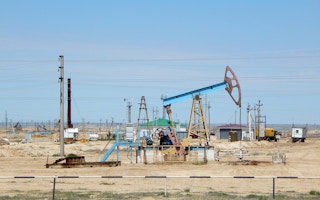The Kazakhstan government has finally published a list of the 55 projects its neighbour China has invested in. About half of the investment total of US$27.6 billion is in oil and gas projects. An itemised list of the projects and their cost has been made available in Kazakh and Russian. Only a summary is available in English.
Rather than try and compete with China in producing goods, the Kazakh government has focused on industrial cooperation as the best means to develop its economy.
The government had previously mentioned the 55 projects in documents and speeches. Since at least 2015, international policy experts and environmental activists have been requesting the list be made public. They were told the projects were too commercially sensitive to be disclosed. In response, they argued that more information would help answer public questions about Belt and Road projects and counter the growth of anti-China sentiment in Kazakhstan.
In 2016, the lack of public participation in decisions relating to the agricultural sector led to mass protests against “selling farmland to foreigners”. Ultimately, the government was forced to delay (until 2021) amendments to the Land Code that would allow foreigners to rent land for up to 25 years rather than 10. Despite this warning, the project list was not made public at the time.
The secrecy may have been prompted by Russia’s experience. In 2008, Moscow published a full list of planned projects with China in its border regions up to 2018. The catalogue featured 100 projects mainly in natural resource extraction for exports and complementary projects in China to produce added-value products from those raw materials. The projects were ridiculed by media and civil society as “colonial”, which contributed to their failure. A new programme between the countries is not publicly available.
A more transparent Belt and Road?
In September, as a new wave of anti-Chinese protests rolled through Kazakh cities with the slogan “Cancel 55 Chinese Projects!”, two non-governmental organisations, Kazakhstan EcoForum and Crude Accountability, again asked the government to publish the list. This time it complied.
The Ministry of Foreign Affairs also gave assurance that “all projects of industrial cooperation included in the List are subject to environmental impact assessment by the State”.
EcoForum chairman Vadim Nee said that, according to the Aarhus Convention and Kazakh law, this will require holding public consultations on each project. He welcomed the government’s commitment to proper public participation and openness.
What are the projects?
The summary shows that 15 projects have already been implemented, 11 are under construction and the remaining 29 are in planning.
Approximately half of the investments are in oil and gas, while the rest are in mining and ore processing, machine manufacturing, energy and food production.
One third of the completed projects aim to produce high added-value products. Of the projects still in planning, the production of finished consumer products accounts for about 10 per cent.
On the bright side, most of the planned energy projects are in wind and solar farms, which contrasts to the miniscule Chinese investment in Russian renewables. The projects list could be much greener, but is better than the rumours spread about it.
“The more public information we have on this cooperation, the less room is left for rumours and fears,” commented Sergey Solyanik, a consultant at environmental organisation Crude Accountability.
“We expect that the Chinese enterprises will adhere to similar openness disclosing social and environmental impacts of planned activities as required by the law… China is our close neighbour and trade partner and we need to develop dialogue on environmental impacts and sustainable development.”
Article 21 of the Environmental Code of Kazakhstan describes procedures for such information disclosure and public participation. But to be able to request that information from developers, the public has to know what projects exist. This is why the belated publication of the project list is seen by many observers as a hopeful sign of policy change under the new Kazakh leadership.
However, uncertainty remains about when and how Chinese companies will disclose the social and environmental impacts of specific projects.
This story originally published by Chinadialogue under a Creative Commons’ License.








